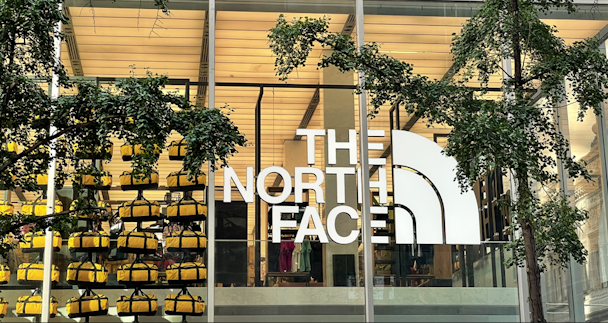The North Face navigates rocky terrain in wake of viral racial inclusion promo
The outdoor gear giant has found itself in the eye of a social storm over its latest promotion awarding customers for taking a racial inclusion survey.

The North Face's latest campaign has garnered mixed reactions from the public and marketers alike / Credit: Adobe Stock
The North Face ignited a social media frenzy last week after its latest promotion offered a 20% discount to customers for participating in an hour-long racial inclusion and allyship course.
Dubbed ‘Allyship in the Outdoors,’ the course claims to educate customers about the challenges faced by people of color in “accessing the outdoors” while helping them become a “better ally and to make the outdoors a safer and more welcoming place for everyone.”
While the move may have garnered The North Face engagement and dollars, it has also sparked a polarizing debate across social media, with opinions ranging from staunch criticism to cautious support.
A report from social media agency Shooglebox, combined with insights from diversity, equity and inclusion (DEI) experts, helps us make sense of the intentions, impact and overall effectiveness of the campaign.
The North Face did not immediately respond to The Drum’s request for comment.
Mapping consumer reactions
A detailed report of the social media discourse conducted by ShoogleBox for The Drum reveals varied reactions to the campaign, with some lauding it as a move towards inclusivity in outdoor spaces, and others condemning it as a shallow exploitation of DEI and other social justice issues.
Right-wing media have been the most vocal about the campaign. On Facebook, Telegraph readers smear the effort as “woke.” The top comment on the Facebook post, with over 420 likes, states: “Countryside is for anyone who wants to enjoy it, this company needs a reality check.”
Others compare the debacle to the backlash that other brands have faced over divisive decisions, such as Bud Light’s explosive partnership with trans influencer Dylan Mulvaney and Gillette’s #MeToo spin on an old campaign, ‘We Believe: The Best Men Can Be.’
There was a slightly more positive response to a TikTok by Fortune Magazine, which garnered over 300,000 views. Some fans of the campaign likened The North Face to Patagonia – the first brand to work with eco drag queen Pattie Gonia. (More recently, The North Face also worked with Pattie, although its ‘Summer of Pride’ campaign last year also drew criticism from right-wing commentators).
However, not everyone on TikTok is a fan of The North Face’s racial inclusion survey. Shooglebox observed Black influencers who responded that, while the intentions are good, the execution hasn’t worked.
In a TikTok stitch to Fortune News, Bme Kween, a Black travel vlogger with 365,000 followers, suggested that the brand offers a discount to the wrong people and should instead be encouraging minority groups into the outdoors. “I see the intention with this campaign, but I think it totally missed the mark,” she said in the video. “We keep seeing brands trying to change the majority instead of creating safe spaces for the minority. This campaign is for allies of under-represented folks in outdoor spaces and nine times out of 10, they don’t need the 20% off ... The people who do need the 20% off are the folks they should be targeting, which are minorities.”
An academic who goes by the name Professor Lyn on TikTok also stitched her reaction to Fortune news to criticize the campaign’s assumption about its audience. “It’s a little messed up that the assumption is that every North Face buyer or user of their products is a white person,” she remarked. “To get 20% off, if I were to do this, it phrases it in a way that is teaching me about white privilege ... Why do I have to do the racism homework to get the 20% off? There’s not an option to be, ‘I am a Black person doing these things.’ Why do I have to take a white privilege class?”
Investigating the brand’s strategy
Some DEI leaders are casting a critical eye toward both the intentions and the impact of the campaign.
Jen O’Ryan, PhD, a DEI consultant, suggests that The North Face’s promotion was primarily driven by marketing goals rather than a genuine commitment to affecting change. “This is where most companies get it wrong; they approach DEI as a transaction,” says O’Ryan. “You can offer a 20% discount for providing feedback on products or joining an email list. Same incentive to shift systems of deeply ingrained biases and patterns of behavior? Not so much.”
By framing DEI as a marketing gap, O’Ryan argues, The North Face overlooks the need to prioritize human-centric strategies. She adds that the organization could have avoided these issues altogether by internalizing DEI values before trying to embed them in external marketing initiatives.
It’s an idea shared by Rachael Kay Albers, a marketing strategist who criticizes The North Face for treating DEI as a mere marketing tool. “When The North Face attached a 20% discount to a course promoting racial inclusion, they revealed their intention: to profit off social injustice and turn ‘allyship’ and ‘inclusion’ into commodities,” she says. “This campaign insults the intelligence of its audience and shows people exactly how The North Face approaches DEI: as a mechanism to make money. Today’s conscious consumers aren’t buying the ‘buy your way to a better world’ message.”
The strategy also risks alienating both socially conscious consumers and conservative audiences alike, Albers points out. “Based on the social media response, The North Face appears to be doing what Bud Light did in 2023: alienating absolutely everyone,“ she says. “They have simultaneously cheapened their stated commitment to DEI, which alienates their core audience of socially conscious consumers, while also drawing ire from conservatives looking to grab headlines over the next branded ‘culture war.’”
Marketing amid political peril
Others point out that backlash might be unavoidable and inevitable, particularly when brands adopt a more explicit stance on social and political issues.
Gabriela Rodrigues, vice-president of impact at Brazil-based creative agency Soko, offers a nuanced perspective on this matter, acknowledging the campaign’s good intentions. “The fact that the campaign was created in collaboration with diversity companies with the purpose of showing that the outdoors should be a welcoming, equitable and safe place for all shows that, yes, the intention was good,” she says.
“The existence of a backlash is not necessarily a sign of a lack of success in the campaign,“ she goes on. “This analysis needs to be done in a more responsible and in-depth way, looking at other company indicators. This is one of the most important lessons to learn: backlash is part of the process, and the fear of experiencing backlash cannot stop the company from taking action.”
She asserts that the need for brands to align their actions with their purpose becomes markedly important in the face of such division.
Sarah Nelson, a digital marketing strategist at progressive nonprofit publisher Berrett-Koehler, asserts the increasing need to embrace DEI in a political moment that she believes has further repressed marginalized voices (pointing to Republican Governor Ron DeSantis’s signing of the ‘Stop Woke Act’ in 2022 as an example).
“DEI initiatives are more important than ever given our political climate,” says Nelson. “The United States has been racist and oppressive since its very beginning. The reason things are so tumultuous lately is that people of color and marginalized communities are speaking out and speaking up, and their allies are standing behind them. The solution isn’t to get quiet and stop talking about it. We must keep being loud and keep supporting each other until there is finally a break in those who resist change.”
Navigating the backlash effectively
Dealing with backlash can be a delicate dance for brands taking strong stances on social and political issues.
Rodrigues suggests that brands need to be explicit about their purpose and evaluate the potential impact of their actions, especially on diverse audiences. They should have plans in place to address any blowback, she says, and most importantly, maintain an unwavering commitment to their purpose, even in times of crisis.
“Do not freeze when the crisis occurs,“ she says. “You know who you are — don’t get lost when someone questions you.”
O’Ryan, meanwhile, proposes a way to prevent marketing missteps in the first place: prioritizing internal groundwork and a thorough understanding of DEI across the organization. She urges organizations to start internally: “Create a psychologically safe environment so diverse perspectives are included and amplified.”
Beyond a company’s organizational culture, she suggests developing meaningful relationships with communities and partnering with DEI experts to get the messaging right.
Albers urges brands to refrain from commodifying social change and, instead, prioritize the cultivation of a just and equitable company culture: “When companies like The North Face heavily invest in marketing themselves as the change – even going so far as to reduce their commitment to inclusion to a coupon code – it begs the question, ‘What comes first? A better world or your bottom line?’”
For more, sign up for The Drum’s daily newsletter here.

